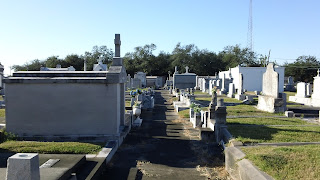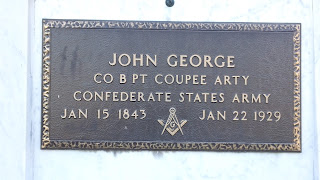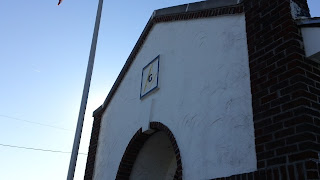The Masonic Cemetery
Masonic Cemetery was purchased by this benevolent
society by having the different lodges chip in to pay for it. People
with money to purchase their own family tombs here did so, while others
pitched in with their lodge brothers to buy larger tombs that would
house a number of lodge members at one time. That way, no one was left
out.
The Masonic cemetery was founded on January 18, 1865,
after two petitions for the establishment of the cemetery. The cemetery
was build while occupying Union forces were still in the city after the
Civil War. The cemetery is divided into sections by Conti St. which
runs through the center. It is surrounded by a cast iron picket fence
and has a few entrances.. The cemetery has many unusual graves,
including a Lodge tomb that has a set of exterior stairs that give
access to the roof of the tomb; a set of columns that were saved from a
Masonic Lodge demolition; and a tomb for the Red River Pilots. The Red
River Pilots was an association of steamboat captains which has long
been disbanded. Most of the graves in the Masonic Cemetery are raised
above the ground with a small retaining wall that has been filled with
soil. Even though there are no grave sites available for sale in this
graveyard and it is not regularly maintained, it is one of the cleanest
cemeteries in the city.
Lafayette No. 1
Lafayette Cemetery was established in 1833 in what is
now known as the Garden District for "Les Americaines" (the Americans).
In 1833, this area was known as the city of Lafayette. It was part of
the Livaudais plantation which was subdivided into city squares in 1832.
This city square was acquired from Cornelius Hurst and the cemetery was
laid out by the city surveyor Benjamin Buisson. The entrance is on
Washington Avenue across the street from the famous restaurant
Commander's Palace. There was a geat division between the Creoles and
the Americans, both literally and figuratively. The "neutral ground" of
what is now Canal street was the physical divider between the Creoles in
the French Quarter and the new Protestant settlers. Upon arrival, one
would notice more Irish and German names on the tombs than the French
and Spanish found in the older St. Louis Cemeteries. There are many
people buried here from the yellow fever epidemic and it is said that
cemetery architecture was just as lucrative as city architecture because
so many people were dying at once.
This cemetery is the only one in New Orleans
dedicated to anyone. It is dedicated to the musician Theodore Von
LaHache in 1823, a musician who founded the New Orleans Philharmonic
Society. The dedication hangs below the front gate entrance on
Washington Avenue. There is a confederate general here, Harry T Hays,
buried in 1876 as well as some Civil War vets. There is a civil war-era
Louisiana Governor Henry Watkins Allen. After the filming of Interview
with a Vampire in this cemetery, the crowds of visitors has increased.
It is now a tourist destination for visitors who want to experience a
part of the New Orleans' "Cities of the Dead."
Saint Louis
St. Louis Cemetery #1 is the oldest and most famous. It was opened in 1789, replacing the city's older St. Peter Cemetery (no longer in existence) as the main burial ground when the city was redesigned after a fire in 1788.
It is 8 blocks from the Mississippi River, on the north side of Basin Street, one block beyond the inland border of the French Quarter. It borders the Iberville housing project. It has been in continuous use since its foundation. The nonprofit group Save Our Cemeteries and commercial businesses offer tours for a fee.
Famous New Orleanians buried in St. Louis #1 include Etienne de Boré, wealthy pioneer of the sugar industry and the first mayor of New Orleans; Homer Plessy, the plaintiff from the landmark 1896 Plessy v. Ferguson Supreme Court decision on civil rights; and Ernest N. "Dutch" Morial, the first African-American mayor of New Orleans.
The renowned Voodoo priestess Marie Laveau is believed to be interred in the Glapion family crypt. Other notable New Orleanians here include Bernard de Marigny, the French-Creole playboy who brought the game of craps to the United States; Barthelemy Lafon, the architect and surveyor who allegedly became one of Jean Lafitte's pirates; and Paul Morphy, one of the earliest world champions of chess. Delphine LaLaurie is also believed to lay in rest here. Architect and engineer Benjamin Latrobe was buried there after dying from yellow fever in 1820 while doing engineering for the New Orleans water works.
The cemetery spans just one square block but is the resting place of many thousands. A Protestant section (generally not vaulted) lies in the north-west section.











































Well done on the pictures. I just found your blog and will follow it now.
ReplyDelete